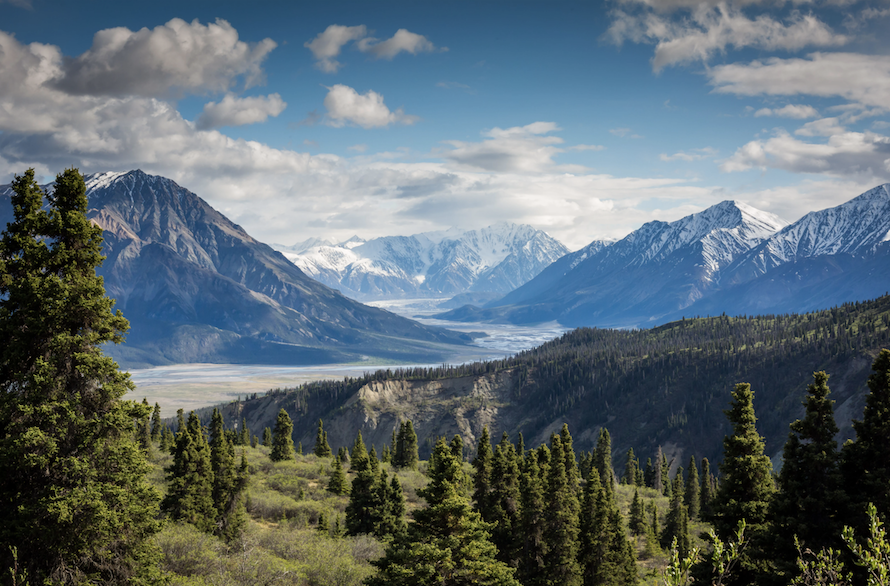
News flash: We found the Vango Airbeam Odyssey Air 500 tent the best performing inflatable tent in the current market.
So you love camping trips, but the idea of connecting the poles to pitch a tent after a long day puts you off.
Welcome to the world of inflatable tents- super-easy to set up while being durable and reliable.
Sounds interesting?
That’s why we have shifted through the latest and best inflatable tents in the market to find out the top picks. In reality, the variety of inflatable tents available isn’t much. Still, picking the best option while balancing quality, performance and price isn’t easy.
However, after hours of evaluation, debates, and checking through the user feedback, we have a complete buying guide ready for you.
In this article, you shall find
- The top choices
- The pros and the cons of each tent
- Their performance in the real world
- And a complete buyers’ guide
So let’s get started.
Top Recommendations
Here’s a quick look at the top choices.
Best overall:
- Vango Airbeam Odyssey Air 500 tent: A reliable all-round performer for friends or a family
Best inflatable tents for 1-2 people
- Heimplanet Original Fistral tent– A lightweight option for backpackers with a super-quick setup
- HEIMPLANET Original, The Cave – The classic Heimplanet tent with top-class stability
- SereneLife Tent– A good family tent that’s easy to set up
Best inflatable tents for 3-4 people
- Quechua Air Seconds 4.1 tent: A spacious choice for summer camping trips
- Quechua Air Seconds Fresh & Black Tent: A good choice for families wanting privacy and to sleep in after sunrise
- Quechua Fresh & Black Air Seconds Tent: A utilitarian tent for small families
- Moose Outdoor Inflatable Tent: An affordable choice for budget buyers
If you want to learn more about inflatable tents before jumping to make a decision, we created these info sections for you:
- Inflatable tents pros and cons
- Can Inflatable Tents Get Punctured?
- Comprehensive buyer guide on how to choose the best inflatable tents
Vango Airbeam Odyssey Air 500
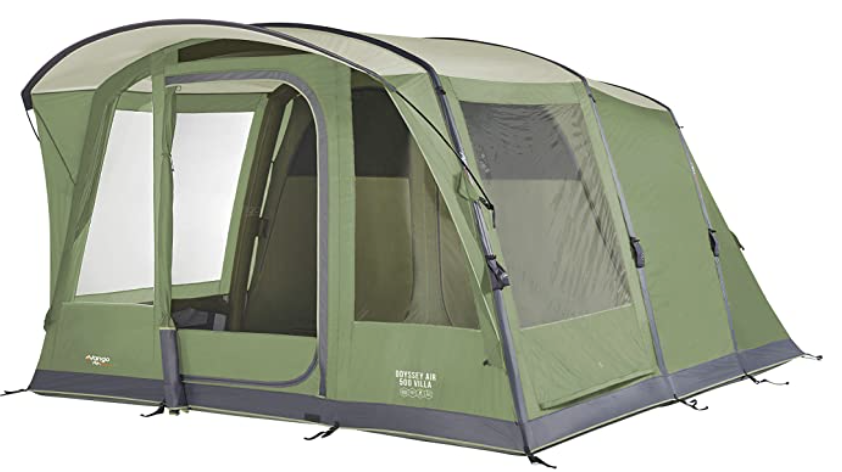
Best for: Campers looking for the best price to performance ratio; $$
Vango has been a pioneer in the field of air beam technology since 2010. The Odyssey Air 500 is one of their most popular designs.
The tent has the air beams fixed in place. All you need to do is inflate it by using the supplied pump.
Vango mentions a pitching time of 8 minutes. First-time users needed around 10 to 15 minutes to get the job done.
Users loved the ample surface area inside the tent that ensures excellent comfort. The capacity is for 5 persons and this is a rare tent that can comfortably fit 5 average-sized persons.
To top it off, there’s also an extended outer area. A practical addition for keeping the inner living space clean and dry.
Tall users loved the liberal headspace the tent provides. With the angled air beams and the upright sidewalls, the available vertical space is more.
Weather resistance won’t be an issue, either. Vango uses Sentinel Active Plus fabric that offers superb strength and 4000 mm of water resistance. Also, the high-quality PE groundsheet is attached to the flysheet with fully-sealed corners. That means you can say goodbye to water seeping in from the ground.
Users also mentioned that the tent withstood moderate winds without any issues. This is thanks to the Tension Band System that prevents sideways movements in windy conditions.
Not to forget, the fabric is also fire retardant and in line with EN5912 safety standards.
The other thing that stands out in most reviews is the superb ventilation in the tent. The windows are designed to allow maximum air and light. There are high and low ventilation panels for the best airflow.
What about the cons?
To be fair, this isn’t a tent for extreme weather conditions including heavy snowfall. It’s limited to camping in mild to moderate weather conditions.
Keep in mind that this isn’t a lightweight tent either. With a weight above 35 pounds, we wouldn’t recommend it for backpacking trips or hike-in sites.
Overall, the Odyssey Air 500 is a superb example of how easy setting up a tent can be without compromising on stability and comfort.
Pros
- A spacious sleeping area
- Great for mild to moderate rain
- Comes with a double-action pump for fast inflation
- Internal divider curtains with toggles
- Cable entry points and bedroom pockets
- UPF30 UV protection
Cons
- A heavy tent
- Waterproofing could be better
Heimplanet Original Fistral Tent
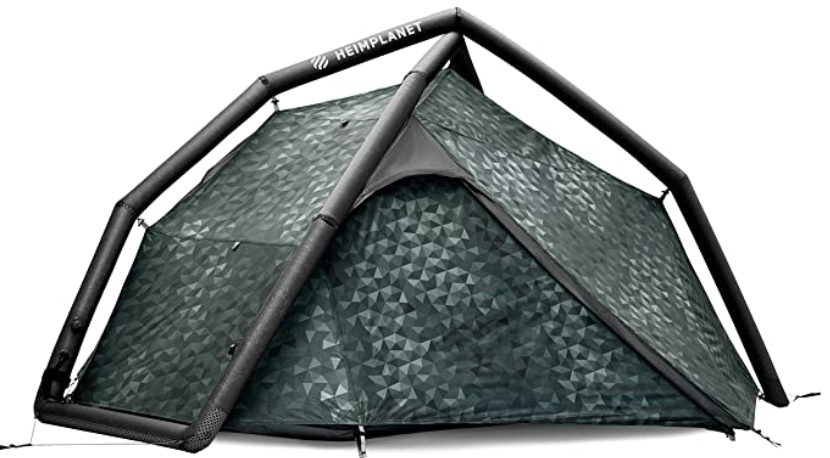
Best for: Backpackers looking for a lightweight but durable tent; $$$
One look at the Heimplanet Fistral tent and the first thing that strikes you is the futuristic design. Point is, not only does it look cool, but it’s also a real champ when it comes to performance.
The thing is, this is a ridiculously lightweight tent. Weighing just 5.5 pounds, this small tent is great for solo backpackers and hikers.
In terms of area, you get 31 square feet. That’s comfortable for a single person but a tight fit for two. The inner tent has a height of 44 inches. Not too bad either.
Users also loved how quickly the tent could be set up and deflated. When the air chambers are connected, you can inflate the tent by connecting the pump with a single valve.
Once it’s set up, the air chambers can be disconnected to engage the Multi-Chamber Safety system. That ensures that the tent remains steady even if one of the chambers leaks.
But that’s not all…
The air chambers are double layered for better durability. In addition, the inner layer can also be repaired easily.
But what about the quality of the valves?
No pressure there!
The tent comes with superior grade 2-in-1 valves equipped with a check valve that’s designed to last.
The user experiences speak highly about the ability of the tent to withstand rough weather. Heimplanet uses a special fabric, Dyecoshell. It combines two types of nylon fibers with a special Dope Dying technology. That delivers superior tensile strength and tear resistance.
Beyond that, the design ensures that this tent can easily withstand heavy winds, making it a great choice for windy conditions.
However, we wish Heimplanet had supplied a pump with the kit. You need to buy the pump separately.
Next, the flysheet comes with 2,500mm of water resistance which is lower than the competition.
Also, the aluminum pegs supplied with the tent aren’t the strongest.
All said and done, the Heimplanet Fistral is a topper when it comes to quality and performance.
Pros
- A geodesic design for superior stability
- Breathable ripstop tent fabric
- Great for tackling rough weather
- High-quality PU groundsheet with 5000 mm water resistance
- Dual entrances for easy access
- Offers excellent portability
Cons
- Not for large groups
- It’s pricey
HEIMPLANET Original, The Cave
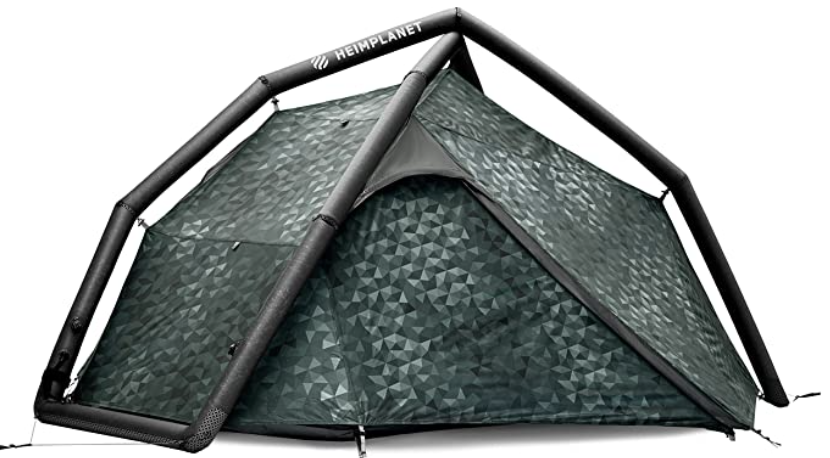
Best for: Outdoor adventurers looking for a rugged and hassle-free tent; $$$
The Cave was the first inflatable tent from Heimplanet. The fact that it still remains a popular option, shows how well it has aged with time.
Most users loved the perfect combination of performance and aesthetics that this tent delivers. While the design is somewhat whacky, its ruggedness is best in class.
Now, the biggest advantage of the cave is the superfast setup time. It’s within a minute or two. Honestly, pitching a tent has never been this easy!
Note, this is a small tent with 54 square feet of ground area that’s best for 2 people. The available headroom is good too.
As expected it’s on the lighter side of the scale with a weight of 10.60 lbs. While that’s not ultralight, it’s not too heavy either.
Reviewers also praised the solid stability of the tent even when wind speeds crossed 60 mph. The geodesic dome construction has ten crossing points that add to the overall structural integrity. On top of that, the flysheet is good enough to tackle moderate rains.
Some users also mentioned even without connecting the guy ropes, the tent was absolutely stable on windy nights.
Astonishing, isn’t it?
On top of that, there are some innovative design features too. That includes the patented Multi-Chamber Safety system and the On-Pump system for easy inflation.
We also loved the fact that there are multiple valves on the air chambers. That helps to eliminate any dead pockets of air before packing the tent.
Users were also satisfied with the ventilation in the tent. Condensation was never a problem, thanks to a large entrance and five separate ventilation points.
That said, this isn’t the best choice when you want to enjoy the views outside. You may not like the lack of large windows.
Strictly speaking, this isn’t a tent for 3 people as Heimplant mentions. But two people will have enough space for a comfortable night. To make matters worse there isn’t much space for storing your gear either. So if you are looking for a family tent, look elsewhere.
Lastly, all the great features make this tent a pricey option. We wouldn’t recommend it for occasional campers or buyers on a budget.
To sum up, this is one of the most advanced inflatable tents in the market with exceptional stability.
Pros
- Top-notch stability and wind resistance
- Star-shaped roof with multiple run-offs for rainwater
- 70D nylon groundsheet with 5000mm water resistance
- Breathable material offers good comfort
- Comes with a repair kit
Cons
- Not the most spacious tent
- Only for extreme backpackers
- A high price tag
SereneLife Tent
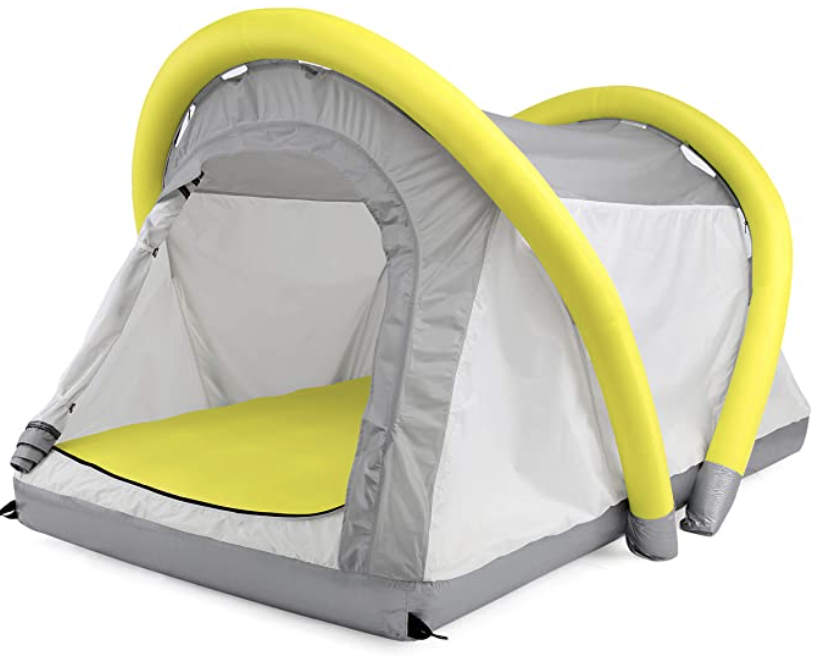
Best for: Budget buyers looking for a versatile and easy-to-use tent and bed combo; $
What makes the Serenelife tent stand out from the rest is the combination of an inflatable tent with an air bed.
To be honest, it’s not as rugged and weather-resistant as some of the other competitors in this segment. But most users loved the fact that it’s an affordable option with the right level of comfort.
For starters, the pitching time with the supplied hand pump is close to 3-4 minutes. That’s not the fastest in this category, but considering the price tag, we aren’t complaining.
Is it spacious?
Not so much. It’s good enough for two medium-sized campers. But quite a few users above 6 feet didn’t find it spacious enough. For a comfortable night, having only one occupant is the best choice.
Reviewers also praised the comfort provided by the mattress. It has a coil beam construction that offers superior support for the back. It uses a heavy-duty PVC and polyester with a weight capacity of 450 lbs.
Serenelife mentions that it’s windproof and waterproof. Most users found the waterproofing to be good in light rain showers. Some also praised the level of warmth it offered on cold nights. The overall stability is also good.
That said, Serenelife doesn’t mention the specifics of the water resistance. So we wouldn’t recommend it for adverse weather conditions.
What’s more, the tent weighs 17.18 lbs. That doesn’t make it a lightweight choice for backpackers.
While the SereneLife tent may lack some of the advanced features, it offers excellent versatility. Users found it ideal for backyard camping and also as an extra bed for sudden guests.
Admittedly, this isn’t the best choice for hardcore adventurers heading for rough terrains. But for casual use and occasional outdoor trips, this inflatable tent offers solid value.
Pros
- An affordable price tag
- Good quality mattress with a high load capacity
- The design makes it easy to clean
- Comes with a hand pump and a carry bag
- Versatile enough for indoor or outdoor use
Cons
- It lacks windows
- Best for a single person
- Lacks storage options
Quechua Air Seconds 4.1
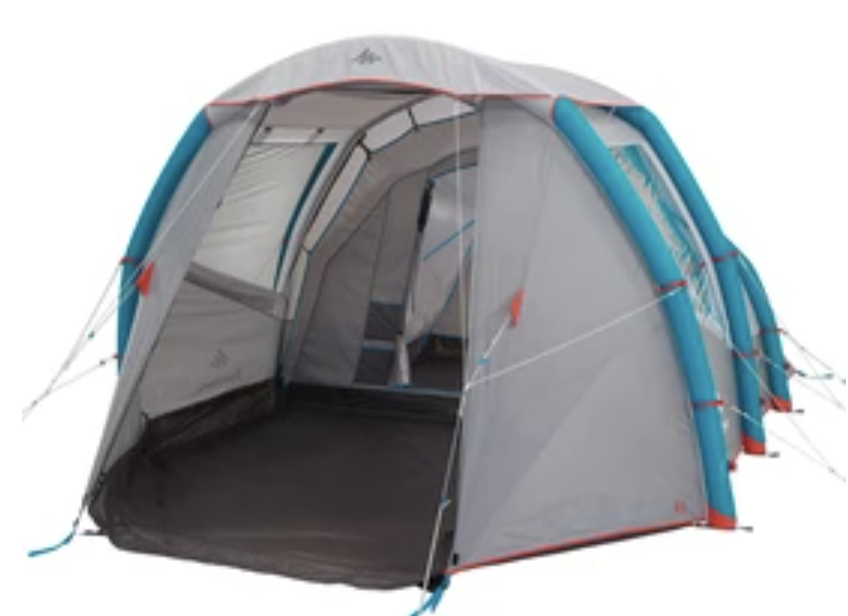
Best for: Families looking for an affordable and functional tent for summer camping; $$
For those looking for a family tent, the Quechua Air seconds is a good choice.
Why do I say this?
To start with, the interiors are very spacious. The 70 square feet of space is divided into two chambers, though there isn’t a divider. The inner space is large enough for a small family and the living space can easily accommodate a few chairs or a bed for a pet.
When it comes to weather resistance, the tent delivers good performance. The polyurethane-coated polyester flysheet offers 2000 mm of water resistance. The tent body can also withstand winds of 35 mph.
However, some users mentioned the tent being blown away when the pegs were not fixed properly on soft ground. So make sure that you peg it down properly.
Reviewers also found the groundsheet to be of good quality. Keep in mind that Quechua uses a groundsheet that works like a basin. That means it is attached to the tent by a toggle system.
Next, users liked the excellent attention to detail. There are multiple air vents and a large vent at the backside for smooth airflow. The insides feel very airy; perfect for summer camping trips.
The tent material permits enough light to enter while blocking the UV rays. Multiple hanging loops and pockets make storing small items super easy.
What about the inflatable poles?
They are quite durable with a 2-layer arch structure – a thermoplastic polyurethane (TPU) air chamber protected by a rugged 600 denier polyester cover. In addition, there’s an aluminum bar to stiffen the living room area.
Coming to the downsides, the lack of insulation doesn’t make this a great choice for snowy conditions. Nor is it ideal for heavy rains.
Weighing 27.6 lbs this isn’t a lightweight tent. The packed size isn’t compact either. So it’s best used for car camping trips. Also, the pitching time isn’t the fastest in this category.
On the whole, Quechua has designed a great family tent with an affordable price tag. While it may not be the best in terms of durability or weather resistance, it can surely be the best value pick.
Pros
- The air beams offer good stability
- The inflatable poles can be repaired easily
- Ventilated flysheet on the living room
- Transparent window with a blackout cover
- Offers great value
Cons
- The bedroom lacks a divider
- Doesn’t come with a pump
- Limited headroom due to sloping walls
Quechua Air Seconds Fresh & Black 4.2
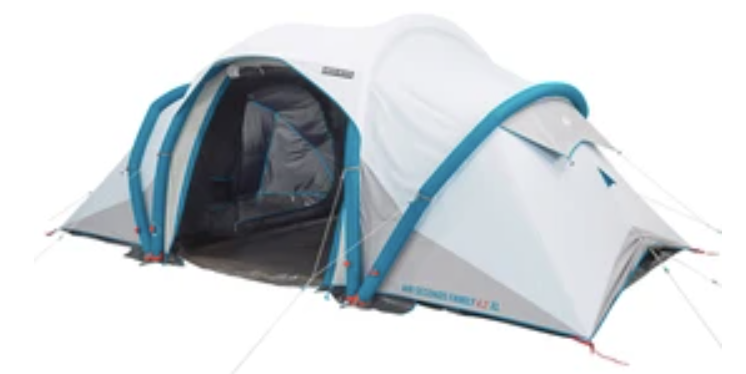
Best for: A family of four looking for a summer tent looking for a great night’s sleep; $$$
OK, I know what you’re thinking. What do the terms Fresh and Black stand for?
Actually, they stand for the combination of “fresh” and “black” fabric in this tent. Quechua says that the “fresh” fabric reduces heat inside the tent and the “dark” fabric ensures 99% darkness in the bedrooms.
In reality, users found the darkness helpful for putting kids to sleep or trying to sleep in after sunrise.
In terms of space, you get 62 square feet of floor area with a maximum tent height of 76.8″. That makes the bedroom comfortable enough for a family of four. However, the sloping walls of the bedrooms reduce the head height.
One more thing…
There are two bedrooms separated by the central living space. That provides the necessary privacy for families.
When it comes to pitching time, this isn’t the fastest option. Inflating the tent with a pump and fixing the guy lines can take anywhere between 10 to 15 minutes.
Users also loved the excellent air circulation in the tent. That makes summer afternoons very comfortable. Apart from the entrance, there’s a large screen window and multiple adjustable vents in each room.
Beyond that, the reviews also mentioned that the tent was sturdy enough to tackle high winds.
Now, Quechua uses a unique combination of dual-layered inflatable poles and aluminum support for structural stability. As per the tests, it can easily withstand winds ranging up to 35 mph.
But the 2000 mm of water resistance in the polyester flysheet isn’t sufficient for tackling heavy rains. We wish Quechua has used material with higher water resistance.
How about portability?
Not good. At 36.4 lbs, this isn’t a tent that you’ll be carrying around between campsites with ease.
All in all, Quechua has done a good job to design a family tent that will satisfy most casual campers. But at this price point, we expected a few more features.
Pros
- Great ventilation and Fresh fabric keeps the interiors cool
- Storage pockets in all rooms
- Heat-sealed seams for better waterproofing
- Fabric offers UPF 50+ sun protection
- A five-year warranty
Cons
- Not for extreme weather conditions
- Doesn’t come with a pump
- Limited headroom due to sloping walls
Quechua Fresh & Black Air Seconds
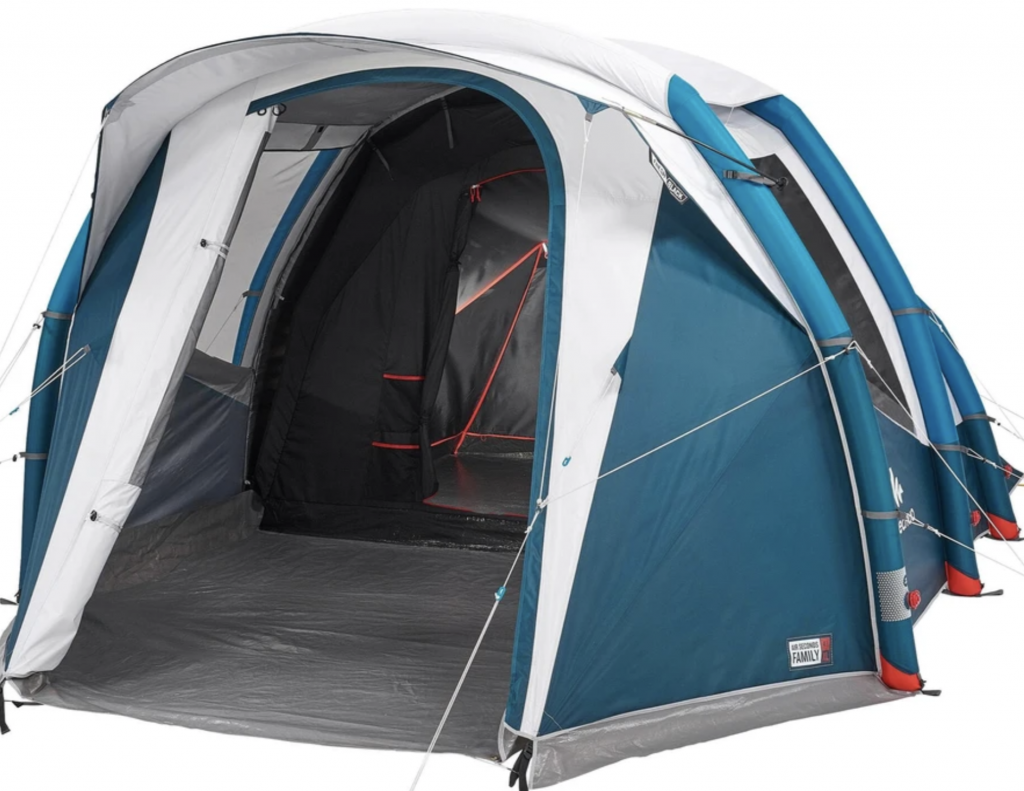
Best for: Couples on a car camping trip looking for a great night’s sleep; $$
In terms of technical features, the Fresh & Black Air is the same as the other inflatable Quechua tents. The major differences are in terms of space and interior layout.
Most users liked the spacious insides that gave it an airy feel. There’s 70 square feet of surface area including the living space. That’s more than the other offerings from Quechua. The living space is also slightly larger. That makes storing gear easier.
The bed compartment isn’t the largest in this category but good enough for a family with two kids. On the other hand, couples will find the bedroom extremely comfortable with enough room to spare.
I have to admit, this isn’t the fastest inflatable tent to set up. It requires 3 to 4 minutes to pump up the support beams. Fixing the aluminum bar and pegging up the structure takes some more time. Still, once you get the hang of it, it’s pretty simple.
Other points the users liked were the blackout bedroom and the superb ventilation. The fabric ensures 99% darkness and also provides protection from UV rays.
Want to sleep late on a bright morning while camping? This is the tent to pick.
The large main entrance and high and low ventilation hatches ensure good airflow. That keeps the interiors airy on a hot summer morning. However, misty and humid conditions can result in some condensation inside the flysheet.
Is the weatherproofing good?
Users found the tent sturdy enough to withstand moderate winds and rain. The polyester flysheet has 2000mm of water resistance. The polyethylene groundsheet has heat-sealed seams to prevent water seepage.
There are dual-layered inflatable poles with an arch structure and an aluminum bar as a stiffener. That makes the tent sturdy enough to withstand 35 mph winds.
Most importantly, Quechua tests their tents in the laboratory to validate these ratings. So these are dependable figures for tackling the occasional rough weather.
Even so, this isn’t the right pick for severe weather conditions. We wouldn’t recommend using it in heavy snow either.
If you’re planning to use it for backpacking or cycling, you’re out of luck. This is a heavy tent, weighing 32 lbs.
Also, Quechua doesn’t include a pump with the tent. That’s disappointing.
Basically, if you’re looking for an easy-to-set-up tent that’s great for a road trip, this is a good choice at an affordable price.
Pros
- The heat resistant fabric keeps the interiors cool in summer
- Multiple storage pockets
- A foldaway basin-shape groundsheet
- The pre-mounted structure ensures easy pitching
- An additional aluminum bar reinforces the living room structure
Cons
- Not for extreme weather conditions
- Doesn’t come with a pump
- Not big enough for 4 large individuals
Moose Outdoor Inflatable Tent
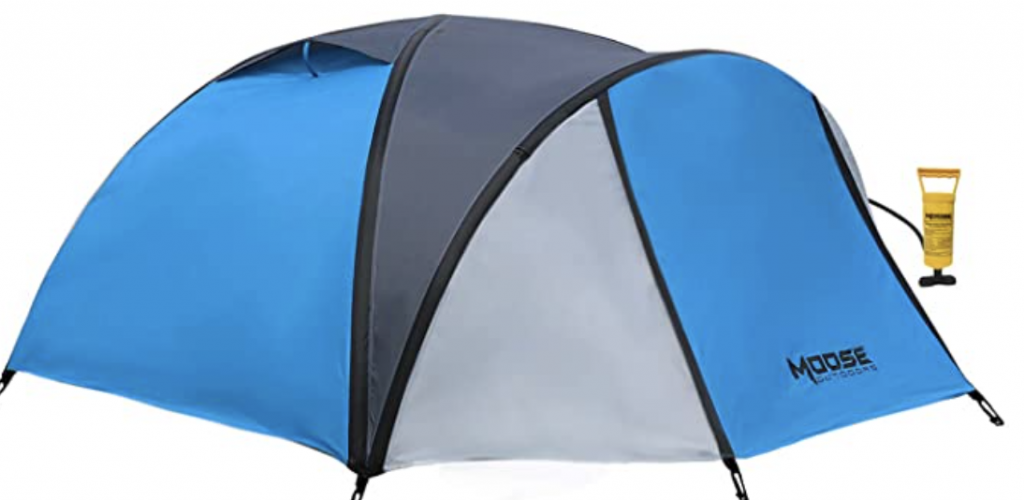
Best for: Budget buyers looking for an easy-to-use tent for occasional camping trips; $
Perhaps unsurprisingly, Moose Outdoors is a relatively lesser-known brand. However, they have a whole range of inflatable tents in their collection with some great features.
In fact, users loved the ease of setting up with this tent. A special QwikFrame technology with durable inflatable pillars ensures a hassle-free installation. With the supplied hand pump, the setup time is just around 5 minutes.
Note, the tent is divided into separate sleeping and storage areas. There’s also a sun-shade area for relaxing.
But here’s the problem.
Even though it’s marked as a 4-person tent, we feel that it’s best for 3 adults. Clearly, two adults will find it extremely comfortable for a glamping trip.
Some users found the interiors quite comfortable while others felt it lacks a few features. Now, comfort is an aspect that no two campers will judge the same way. But considering the price tag, we feel that this tent offers the right bang for the buck.
Coming to the material quality, the ripstop material is rugged enough to resist punctures. Beyond that, it’s also waterproof up to 3000 mm and fire-resistant.
Other than that, the special QwikFrame technology also makes this tent stable enough to withstand winds of 33 mph. Still, this isn’t the right tent to pack while heading into rough weather.
None of the users mentioned any issues with the ventilation in the tent. It comes with airflow technology that has two riser vents to allow cool air to flow in. The vents are covered to prevent any water leakage.
One downside a few users mentioned is the tent gets hot under the sun. There were also reports of an airbeam bursting in the heat.
Moose Outdoors provides a 3-month warranty on the product. That’s less than what the competitors provide.
In terms of price to performance ratio, this tent is a value for money choice. But if you’re looking for premium quality and better features, there are other options.
Pros
- A versatile tent for car camping, picnics, or backyard gatherings
- Single valve operation for quick deflation
- Offers good value for budget buyers
- Comes with an air pump, carrying bag, and repair patches
- Fabric is UV resistant and rated for low temperatures
Cons
- Material quality isn’t the best in this category
- At 15 pounds, it’s not for backcountry hikes
- Not big enough for 4 large individuals
Inflatable Tents
The design and style of tents have advanced through the years, with inflatable tents being one of the latest innovations in tent design.
Within a short time, they have become quite popular among a section of outdoor lovers.
So before we go into the buying guide, let’s take a closer look at these tents and how they function.
Instead of having fiberglass or metal poles used in traditional tents, inflatable tents come with an air tube structure. These tubes form the basic supporting members. In addition, they are also tied down by guy lines.
This leads to one of the major differences of inflatable tents — setting them up is incredibly simple and much quicker than a traditional tent. All you need to do is pump it up through the provided valves and peg down the structure.
And the best part is – there are no poles! So no more struggling about locking the poles in their right places.
Taking down the whole structure is just as easy. This makes inflatable tents a great choice for beginners.
Perhaps you‘re thinking that air can’t be as strong as metal or fiberglass. Think again.
The fact is, air beam technology has advanced a lot through the years.
In modern inflatable tents, a high-strength 3-D fabric is weaved to create a smooth seamless tube that offers solid structural strength. The diameter of the tubes can vary, depending on the level of support required.
Other than that, high-quality inflatable tents have sufficient structural stability to withstand strong winds. They are flexible enough to sway with strong winds. Unlike traditional tents, there’s little risk of a pole snapping in the middle of a storm.
Such qualities make them great for camping in wide-open spaces or near a windy coastline.
Here are a few pros and cons of inflatable tents.
Pros
- Quick and easy setup
- It can be set up or dismantled by one person
- Minimum use of hardware makes packing the tent user-friendly
- They are easy to repair with a standard patch up kit
Cons
- They come with a higher price tag than standard tents
- An air pump is required for inflation
- The packed size is bulky
- Not many options or variants available
Can Inflatable Tents Get Punctured?
Yes, they can. But before you think that these tents are flimsy, let me just say, such a scenario is highly unlikely.
Let me explain.
These tents are made from top-grade Thermoplastic Polyurethane (TPU) material that’s specially treated to resist abrasions. So they aren’t the lightest ones out there.
The superior fabric quality also gives some inflatable tents a high price tag. Overall, these tents are designed to withstand sharp objects like rocks, twigs, or insects.
That said, they aren’t indestructible. It’s best to take the right precautions and pitch them on a flat and clear surface to prevent any damage. Also, proper storage and transportation are crucial in making them last longer.
Note, even if there’s a puncture, the tent won’t collapse on you. These tents are designed with multiple channels or partitions. So one leak won’t affect the overall performance.
And inflatable tents can be repaired easily by using a puncture kit. Tubes can also be replaced if they are severely damaged.
At times, a sharp drop in temperature can lower the air pressure. This may cause the air beams of the tent to look deflated, even if there’s no puncture. So no need to worry too much. You can solve this problem by pumping more air into the tubes if you expect the temperature to remain low.
How to Choose the Best Inflatable Tent
We all know choosing the right tent can be hard work. So we have compiled the most important points to check while picking an inflatable tent. Whether you are a pro camper or a newbie, this guide will surely help you out.
Shape and Design
Inflatable tents come in a variety of designs. While some are practical for more serious campers, others are great fun for family outdoor trips.
Here are a few common types:
Inflatable Dome Tents
One of the most popular tent shapes, the classic dome has been around for quite some time. Keep in mind that these are best for small families. In most cases, large dome tents aren’t the most stable options.
Inflatable Geodesic Tents
These tents are an improvement over the traditional dome tent with additional supports running across the top. The supports crisscross to form multiple triangles on the surface of the tent. The result? Better structural stability in rougher weather conditions.
Inflatable Tunnel Tents
These tents are great for family use as they are very spacious. Some models also come with multiple rooms. The stability isn’t as good as geodesic tents but the fun factor is much higher.
Inflatable Bubble Tents
While transparent bubble tents look great, they aren’t the most popular choice for camping. They are mostly used for backyard fun sessions with family or friends.
In truth, you would probably choose the tent style based on personal preferences. But your use cases, space requirement, and practical features also play an important role.
If you are a first-time buyer, try to visit a camping show to get an idea about the various types of inflatable tents and their features.
Size and Capacity
The most important factor in deciding how much space you need is the number of occupants. In general, an average-sized adult needs around 20 to 25 square feet of space, or ~36” x 80”, to rest comfortably in a tent. It’s important to take into account the age, weight, and physical characteristics of each occupant.
Keep in mind that the occupation rating or capacity provided by the manufacturer shouldn’t be taken at face value. For better comfort, you should buy a bigger tent (1 – 4 people larger) than the actual number of campers you expect.
Don’t forget to check the roof height of the tent. A taller tent will feel more spacious, adding to the comfort level. Beyond that, you need to consider the space required for storing gear and other items.
When it comes to the layout inside the tent, some only come with a single compartment. Others may have sleeping compartments and living areas separated by a room divider. This will offer more privacy to large groups and families.
The size will also impact the weight of the tent. Larger inflatable tents may be difficult to carry around since they are built with heavy and high-quality materials. Just keep this in mind if you are planning to go to a hike-in site or even backpack with an inflatable tent. Essentially, you want to strike the right balance between weight and comfort.
That said, for most car camping trips, weight isn’t an issue. So you can go for a bigger size without hesitation.
Other than that, many buyers fail to consider how to store the tent when it’s not in use. Keep in mind that large inflatable tents will need considerable space for proper storage. For example, the Vango Airbeam Odyssey measures 70 x 36 x 35cm when packed.
The Material Quality
This is one of the most important factors in determining how rugged and weather-resistant your tent would be. Almost all types of fabrics used in inflatable tents have two important parameters — enhanced structural performance and better environmental resistance.
According to this study, apart from enhanced nylon and polyester yarns, some inflatable tents are also made from special materials like Dacron or Spectra.
Ideally, you should choose high-grade ripstop material for inflatable tents. These fabrics improve resistance to punctures and tearing. For example, Heimplanet uses nylon 40D 240T ripstop for the inner tent.
Some fabrics also come with a Denier (D) rating based on the thickness and weight of the individual threads. Keep in mind, higher the rating, the stronger the fabric.
A major advantage of these fabrics is, even if an airbeam is overloaded, the fabric structure isn’t usually damaged. Once the load is removed, the fabric can restore itself.
It’s best to choose an inner tent fabric that’s marked as breathable. That reduces the chances of condensation inside the tent.
In most cases, the material is UV resistant with a high waterproof rating. Quite often, the level of waterproofing is improved by a special silicone coating.
Note, waterproofing is measured by Hydrostatic Head Rating. If the rating of the tent material is 3000mm, it means that it’s good enough to handle moderate rain and light snow. Most three-season tents come with a rating of 3000 mm or more.
In case you want protection from heavier rain and snow, choosing a rating between 5000mm to 10000mm is the best choice. In other words, the higher it is, the better.
It’s also necessary to check the quality of the groundsheet to ensure it can resist wear and tear and prevent water seepage. The groundsheet should also be made from the same grade of fabric as the tent structure.
Also, check the quality of the seams. They should be sealed or welded to prevent any leakage.
The Valve Quality and Location
There are a variety of valve arrangements on inflatable tents. Some have single inflation valves with an outlet valve on each air tube. Others come with a single valve for inflation as well as deflation.
In most cases, the valve design is simple enough for easy use. Make sure to check the quality of all the valves to ensure they will last long.
While you can’t judge a valve from its looks, most reputed brands offer top-grade valves in their tents.
This is why picking a tent with a good warranty is also important. Look for a lifetime warranty and good after-sales service by the manufacturer. That will ensure that you get hassle-free repairs or replacements in case of any issues.
Other than that, check the location of the valve and ensure it’s convenient. It shouldn’t be too close to the ground, in which case, dirt or mud can block the valve opening.
Accessories
The most important accessory of an inflatable tent is the air pump. Some come with a pump, while others don’t.
A double-action pump- like the one supplied with the Coleman Fastpitch Air Valdes tent- is the best choice since it’s more efficient. If you have to buy a separate pump, you may need an adaptor to match the valve sizes.
If you want something more comfortable, pick a battery-operated pump.
The other important item is a repair kit that will help you to patch up any accidental punctures in the air beams. Before you head out, make sure to read the guidelines about using the repair kit.
A tent can also come with internal features to improve the overall user experience. These can include hooks or straps for attaching lights and storage pockets for gadgets. Entry points for electrical wires are also a nice addition.
Ventilation
Ventilation can be more of an issue with inflatable tents than traditional ones. There can be condensation on the air beams, resulting in water dripping on the insides.
Imagine what that would feel like on a cold night!
To prevent that, some brands use special design features with multiple ventilation ports for better airflow. The Vango Airbeam Odyssey is one such example. Mesh panels and air vents help, too.
However, on cold and windless nights or during rainy conditions, the chances of condensation still remain. Take a look at a few steps you can take to prevent condensation.
Access points on the tent will also impact ventilation. Tents with two doors, one on each end, will provide better airflow. Openings should also have mesh covers to keep out the bugs.
Price
Obviously, price is an important consideration no matter the type of tent you buy. This is where in-depth research of the best products can help you to make the best-value-for-money choice.
The price of inflatable tents can range anywhere between $70 to $800 based on the features and quality. With such a wide price range, it’s important to know what you need before picking.
Keep in mind that good-quality inflatable tents don’t come cheap. So if you’re a frequent camper and want a tent that will last long, it’s better to think of it as an investment. This is even more true if you camp often in rough weather conditions.
If you’re on a tight budget, try to pick a model during the end-of-season sales. That way, you may get great discounts on models that are otherwise too expensive for you.
Many of us may not have the budget to afford the latest models. So tents that are a few seasons old can be a good value choice.
Also, prices can vary between stores. Check out all the buying options before making the purchase.
Final Verdict
So it all adds up to this —
The Vango Airbeam Odyssey Air 500 is the best choice in this category. Vango brought the revolutionary inflatable airbeam technology in this field. The high-end design of this tent proves that they are still the leaders.
If you don’t mind the high price tag, the super-light Heimplanet Fistral is a great choice for solo travelers. It easily matches traditional tents in terms of durability and weather resistance. What really shines is the super-fast and hassle-free set-up.
Inflatable tents are perfect for family camping trips where weight isn’t a factor. Quite simply, when you want to put your feet up and relax on a holiday, they are a great choice.
We have done all the hard work to make the process of picking the best inflatable tent easy for you.
So go ahead and take your pick.














